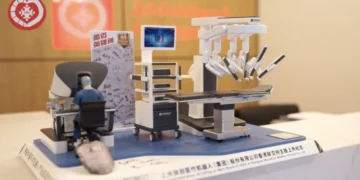Robotic kidney surgery with organ preservation, also known as partial nephrectomy, is an innovative and targeted method where the surgeon removes only the damaged or diseased tissue from the kidney while preserving the remaining healthy part. This procedure is especially important when the tumor or pathology is small and complete removal of the kidney is not necessary.
Key features of robotic partial nephrectomy:
- Organ Preservation: The goal of the surgery is to preserve as much healthy kidney tissue as possible, maintaining long-term kidney function for the patient.
- Precise Tumor Removal: Robotic surgery allows the surgeon to remove only the affected tissue with great accuracy, avoiding damage to healthy parts of the kidney and reducing the risk of cancer recurrence.
- Minimally Invasive: Like other robotic procedures, partial nephrectomy is performed through small incisions, resulting in less trauma, reduced pain, and a shorter recovery period for patients.
Key Advantages:
- Enhanced Precision: The robotic system enables more precise surgeries, allowing the surgeon to perform complex procedures such as preserving kidney function while removing the tumor.
- Minimized Blood Loss: Smaller incisions and controlled, accurate movements reduce blood loss during the operation.
- Less Pain and Scarring: Patients experience less post-operative pain and are left with smaller, less noticeable scars.
- Faster Recovery Time: Compared to open surgery, patients who undergo robotic kidney surgery typically return to normal activities more quickly. Hospital stays are shorter, and recovery is faster.
- Better Outcomes: In oncological cases, robotic surgery allows the surgeon to remove cancerous tissue with minimal damage to healthy kidney tissue, improving long-term outcomes and preserving kidney function.
Who Is It Recommended For:
- Patients with small to medium-sized kidney tumors.
- Individuals at risk of losing kidney function if removal of both kidneys becomes necessary.
- Patients eligible for organ-preserving surgery depending on the tumor’s stage or type.
Postoperative Process:
- Hospital Stay: After robotic partial nephrectomy, patients typically stay in the hospital for 1–2 days.
- Physical Limitations: Light activities should be avoided for 2–3 weeks.
- Care and Monitoring: Regular follow-up visits with the surgeon are essential during the postoperative period, including MRI or CT scans to evaluate the success of the procedure and detect any potential complications.
Conclusion:
Robotic kidney surgery with organ preservation is one of the most advanced methods in modern medicine. It offers patients not only a chance of survival but also the preservation of kidney function to the greatest extent possible. This approach is especially effective in cases where kidney cancer or other conditions are detected at an early stage, leading to better outcomes and a quicker return to normal life.
“Kharazishvili Robotic Center” offers treatment using techniques aligned with global medical standards.







